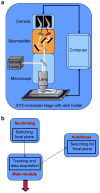Calcium imaging of multiple neurons in freely behaving C. elegans
- PMID: 22260981
- PMCID: PMC3378253
- DOI: 10.1016/j.jneumeth.2012.01.002
Calcium imaging of multiple neurons in freely behaving C. elegans
Abstract
Caenorhabditis elegans is a popular model organism to study how neural circuits and genes regulate behavior. To reliably correlate circuit function with behavior, it is important to record neuronal activity in freely behaving worms. As neural circuits are composed of multiple neurons that cooperate to process information, it is highly desirable to simultaneously record the activity of multiple neurons in the circuitry. However, such a system has not been available in C. elegans. Here, we report the CARIBN II (Calcium Ratiometric Imaging of Behaving Nematodes version II) system. This system provides smoother data collection and more importantly permits simultaneous imaging of calcium transients from multiple neurons in freely behaving worms. Using this system, we imaged the activity of AVA and RIM, two key neurons in the locomotion circuitry that regulate backward movement (reversal) in locomotion behavior. We found that AVA activity increases while RIM activity decreases during the same reversal events in spontaneous locomotion, consistent with the recent report that the AVA and RIM are involved in promoting the initiation of reversals. The CARIBN II system provides a valuable tool for dissecting the neural basis of behavior in C. elegans.
Copyright © 2012 Elsevier B.V. All rights reserved.
Figures


References
-
- Alkema MJ, Hunter-Ensor M, Ringstad N, Horvitz HR. Tyramine Functions independently of octopamine in the Caenorhabditis elegans nervous system. Neuron. 2005;46:247–60. - PubMed
-
- Barr MM. Super models. Physiol Genomics. 2003;13:15–24. - PubMed
-
- Ben Arous J, Tanizawa Y, Rabinowitch I, Chatenay D, Schafer WR. Automated imaging of neuronal activity in freely behaving Caenorhabditis elegans. J Neurosci Methods. 2010;187:229–34. - PubMed
-
- Chalasani SH, Chronis N, Tsunozaki M, Gray JM, Ramot D, Goodman MB, Bargmann CI. Dissecting a circuit for olfactory behaviour in Caenorhabditis elegans. Nature. 2007;450:63–70. - PubMed
Publication types
MeSH terms
Grants and funding
LinkOut - more resources
Full Text Sources
Molecular Biology Databases
Research Materials

